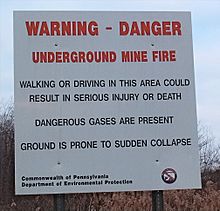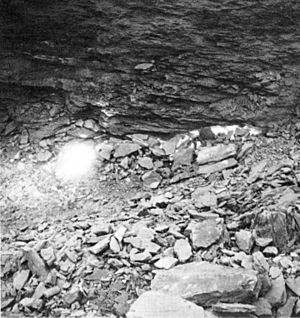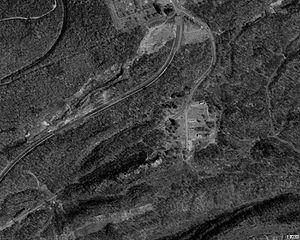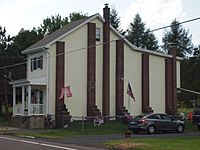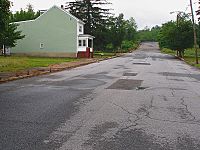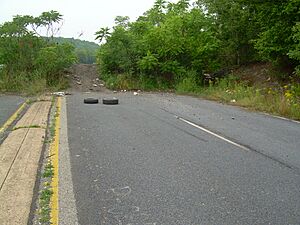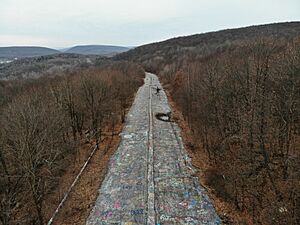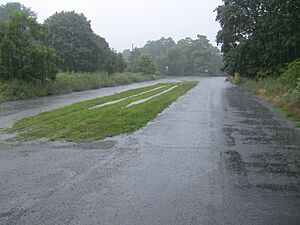Centralia, Pennsylvania facts for kids
Quick facts for kids
Centralia, Pennsylvania
Bull's Head
|
|
|---|---|
|
Borough
|
|
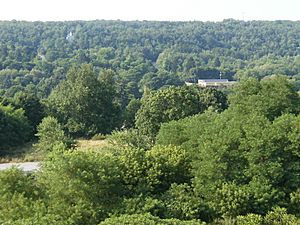
Centralia as seen from South Street, July 2010
|
|

Location of Centralia in Columbia County, Pennsylvania
|
|
| Country | United States |
| State | Pennsylvania |
| County | Columbia |
| Settled | 1841 (as Bull's Head) |
| Incorporated | 1866 (Borough of Centralia) |
| Founded by | Jonathan Faust |
| Area | |
| • Total | 0.24 sq mi (0.62 km2) |
| • Land | 0.24 sq mi (0.62 km2) |
| • Water | 0.00 sq mi (0.00 km2) 0% |
| Elevation | 1,467 ft (447 m) |
| Population
(2020)
|
|
| • Total | 5 |
| • Density | 20.833/sq mi (8.08/km2) |
| Time zone | UTC-5 (Eastern (EST)) |
| • Summer (DST) | UTC-4 (EDT) |
| ZIP Code | |
| Area code | 570 |
| FIPS code | 42-12312 |
|
|
Centralia is a small town, or borough, in Columbia County, Pennsylvania, United States. It is often called a near-ghost town. This is because a coal mine fire has been burning underground since 1962!
Because of the fire, Centralia's population has shrunk a lot. In 1980, about 1,000 people lived there. By 2020, only five residents remained. Centralia is now the least-populated town in Pennsylvania. It is completely surrounded by Conyngham Township.
In 1992, the state of Pennsylvania took control of all the land in Centralia. This was done using a process called eminent domain. This means the government can take private property for public use, even if the owner doesn't want to sell. Centralia's ZIP Code was stopped in 2002. In 2013, the last few residents were allowed to stay in their homes for the rest of their lives. After they pass away, the state will take their houses.
Contents
Centralia's Story: A Town's History
How Centralia Began
Long ago, in 1749, Native American tribes sold the land where Centralia is now. This land was bought by colonial agents. In 1770, a road called Reading Road was built through the area. This road later became part of Route 61, which is the main highway into Centralia.
In 1793, Robert Morris, a hero from the Revolutionary War, bought a large part of Centralia's valley. He later went bankrupt. In 1798, a French sea captain named Stephen Girard bought the land. He knew there was valuable anthracite coal in the area.
The coal in Centralia became important after the Mine Run Railroad was built in 1854. Before that, in 1832, Johnathan Faust opened a tavern called Bull's Head. This gave the town its first name, Bull's Head. In 1842, the Locust Mountain Coal and Iron Company bought Centralia's land.
Alexander Rae, a mining engineer, moved his family there and planned the town. He named it Centreville. But in 1865, he changed the name to Centralia. This was because another town in Pennsylvania already had the name Centreville.
Coal Mining and Growth
The first two coal mines in Centralia opened in 1856. More mines followed, like the Hazeldell Colliery Mine in 1860. The Centralia Mine opened in 1862, and the Continental Mine in 1863. A railroad was built to Centralia in 1865. This helped transport coal to other parts of Pennsylvania.
Centralia officially became a borough in 1866. Most people worked in the anthracite coal industry. Alexander Rae, who founded the town, was sadly killed in 1868. This happened during a time of conflict with a group called the Molly Maguires. They were trying to form a mineworkers union to get better pay and working conditions.
Many other violent events happened during this time. A local legend says that a priest, Father Daniel Ignatius McDermott, put a curse on the land. He said that one day, only the St. Ignatius Roman Catholic Church would remain. The Molly Maguires' leaders were stopped in 1877.
Centralia grew a lot. In 1890, it had its largest population of 2,761 people. At its busiest, the town had seven churches, five hotels, and many stores. But after 1929, coal production started to decline. Many mines closed, and some miners continued to dig for coal illegally. This made the mines unstable.
By 1950, Centralia had 1,986 residents. The town council gained the rights to all the coal under Centralia. Coal mining continued until the 1960s, and some mining still happens nearby today.
Train service to Centralia ended in 1966. The town also had its own school district. By 1980, Centralia had 1,012 residents.
The Mine Fire Starts
People don't fully agree on how the Centralia fire started. One idea is that it began in May 1962. The town council hired firefighters to clean up the town's landfill. This dump was in an old strip-mine pit. The firefighters set the trash on fire, as they had done before. But this time, the fire was not fully put out. It spread into the old coal mines underground.
Another idea is that the fire started a day earlier. A trash hauler might have dumped hot ash into the pit. The town was supposed to put a clay barrier between layers of trash, but it wasn't finished. This could have let the hot coals reach the coal vein below. There's also a legend that an older coal fire from 1932 was never fully put out and reached the landfill in 1962.
How the Fire Affected the Town
In 1979, people started to realize how big the problem was. A gas station owner found that his underground fuel tanks were very hot. The gasoline was 172°F (78°C)!
The fire got more attention in 1981. A 12-year-old boy named Todd Domboski fell into a sinkhole that suddenly opened in his backyard. It was 4 feet (1.2 m) wide and 150 feet (46 m) deep! His cousin saved him. Hot steam came from the hole, and it had a dangerous level of carbon monoxide.
Even with this evidence, people in Centralia disagreed about how dangerous the fire was. In 1984, the U.S. Congress gave over $42 million to help people move. Most residents accepted money and moved to nearby towns.
In 1992, Pennsylvania's governor, Bob Casey, used eminent domain to take all property in Centralia. This meant the state took control of all buildings. In 2002, the U.S. Postal Service stopped using Centralia's ZIP code. In 2009, Governor Ed Rendell began to formally move out the remaining residents. The fire also spread to a nearby village called Byrnesville, which also had to be abandoned.
Centralia Today: A Quiet Place
Very few homes are left in Centralia. Most abandoned buildings have been torn down or taken over by nature. The area now looks like a field with paved streets running through it. New trees are growing in some places.
The only church still standing, St. Mary's, holds services every Sunday. The fire has not directly affected it. The town's four cemeteries are still kept in good condition. One cemetery on a hilltop even has smoke rising around it!
The fire is burning under about 400 acres (1.6 km2) of land. You can see signs of it from low metal vents in the ground. Signs warn people about the underground fire, unstable ground, and dangerous levels of carbon monoxide. Smoke and steam also come from an old part of Pennsylvania Route 61. This road was closed and blocked off in 1993 because of the fire. The underground fire is still burning and might continue for 250 more years!
In 2010, only five homes remained. In 2013, the remaining residents reached an agreement. They received money for their homes and could stay there for the rest of their lives.
The Centralia Borough Council still meets regularly. In 2012, the town's highest bill was for electricity, which was $92. The town's budget was "in the black," meaning it had money.
A Time Capsule Story
In May 2014, a time capsule buried in 1966 was opened earlier than planned. Someone had tried to dig it up and steal it. The capsule was supposed to be opened in 2016. Inside the footlocker-sized capsule, which had water in it, were things like a miner’s helmet, a miner’s lamp, some coal, a Bible, and local souvenirs.
Why the State Took the Land
Some people in Centralia believe the state took their land to get the mineral rights to the anthracite coal underneath. They think the coal is worth hundreds of millions of dollars.
This idea comes from state laws. If a town no longer has enough residents to form a government, it legally stops existing. If that happens, the mineral rights, which belong to the Borough of Centralia, would then go to the state of Pennsylvania.
Centralia's Population Changes
| Historical population | |||
|---|---|---|---|
| Census | Pop. | %± | |
| 1870 | 1,342 | — | |
| 1880 | 1,886 | 40.5% | |
| 1890 | 2,761 | 46.4% | |
| 1900 | 2,048 | −25.8% | |
| 1910 | 2,429 | 18.6% | |
| 1920 | 2,336 | −3.8% | |
| 1930 | 2,446 | 4.7% | |
| 1940 | 2,449 | 0.1% | |
| 1950 | 1,986 | −18.9% | |
| 1960 | 1,435 | −27.7% | |
| 1970 | 1,165 | −18.8% | |
| 1980 | 1,017 | −12.7% | |
| 1990 | 63 | −93.8% | |
| 2000 | 21 | −66.7% | |
| 2010 | 10 | −52.4% | |
| 2020 | 5 | −50.0% | |
| 2021 (est.) | 4 | −60.0% | |
| Sources: | |||
Many people in Centralia were from Ukrainian or Russian families. The town once had both a Ukrainian Catholic church and a Russian Orthodox church.
Centralia's Population in 2010 and 2020
In 2010, there were ten people living in Centralia. They lived in five households. All the residents were white. The median age was 62.5 years old. There were five females and five males.
By 2020, only five people lived in Centralia. Most were white, and one person was Asian. One resident was under 18 years old.
Town Services and Community Efforts
The Centralia Municipal Building and its fire station garage are still standing. The building was fixed up in 2012. It hosts an annual Centralia Cleanup Day. Volunteers collect trash that has been illegally dumped in the area. In April 2021, volunteers planted 250 apple trees around Centralia. This helps restore the town's nature and animal homes.
The town's Ukrainian Catholic church, the Assumption of the Blessed Virgin Mary, is still used. People from nearby towns, including former residents, come to worship there. A study found that there is solid rock, not coal, under the church. This means it is safe from the fire. An Eastern Orthodox cemetery also stands on the edge of Centralia.
Centralia in Books and Movies
Centralia has inspired many fictional ghost towns and scary places. For example, it was used as a model in Dean Koontz's Strange Highways and David Wellington's Vampire Zero.
Screenwriter Roger Avary studied Centralia when writing the movie Silent Hill. Many people think Centralia inspired the whole Silent Hill video game series, but it was mainly for the movie.
See also
 In Spanish: Centralia para niños
In Spanish: Centralia para niños




